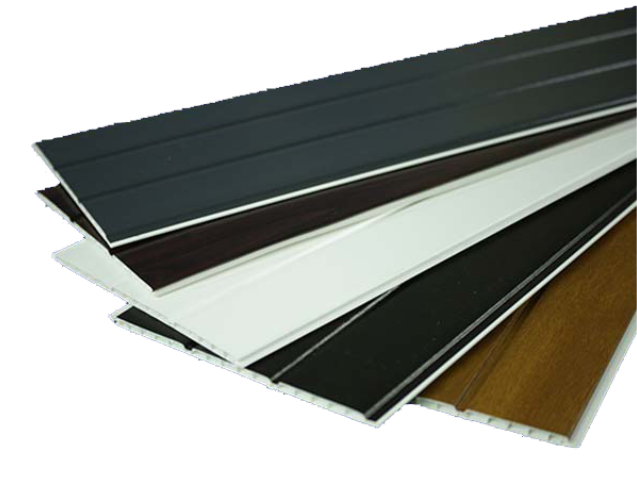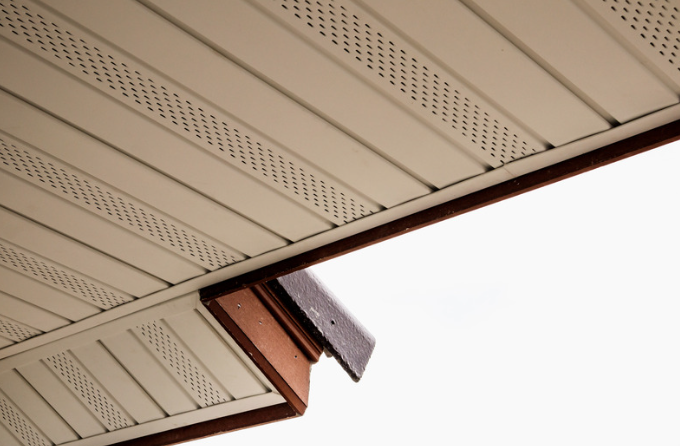What are the Different Types of Soffits?
If you have ever looked up at the edge of your roof, you might have noticed a strip of material that covers the gap between the roof and the wall. This is called the soffit, and it is an essential part of your house. Soffits not only add style to your home, but also protect the home from water damage and improve ventilation. But did you know that there are different types of soffits, each with its own advantages and disadvantages?
In this article, we will explain the different types of soffits and how to choose the best type of soffit for your home.
What are the Different Types of Soffits by Material?
One of the main factors to consider when choosing a soffit is the material.
UPVC & PVC-UE
UPVC (unplasticized polyvinyl chloride) & PVC-UE (polyvinyl chloride - unplasticized expanded) are plastic soffits that are more rigid and durable than regular PVC soffits. They are also more resistant to UV rays, chemicals, and impacts, lasting longer without cracking or peeling. UPVC soffits are similar to vinyl soffits in terms of colours and styles.

Pros:
- Weather Resistance: UPVC is a strong and resilient material that can withstand harsh weather conditions. It won't rust, corrode, or deform easily, ensuring a long lifespan.
- Variety of colours: Our UPVC soffits are available in a variety of colours, including white, agate grey woodgrain, anthracite grey woodgrain, black ash woodgrain, golden oak woodgrain, rosewood woodgrain, chartwell green woodgrain, storm grey, dark grey, and black. You can also choose between a plain, hollow and vented style. This allows you to match the existing aesthetics of your home.
- Low Maintenance: UPVC soffits are highly resistant to scratches and dents, providing long-term protection for your roofline. They require minimal maintenance compared to other materials like wood, which needs periodic painting or staining. UPVC soffits only need occasional cleaning with soap and water.
- Cost-effective: UPVC is one of the most affordable options for soffits, making it a budget-friendly choice.
- Easy to install: UPVC soffits are also lightweight and relatively easy to install, making them a good option for DIYers or to reduce installation costs.
- Fire Retardancy: Our soffit boards carry a Class 2Y surface spread of flame rating in accordance with BS 476-7: 1997.
Cons:
- Brittle and fading with age: UPVC soffits exposed to harsh sunlight over time may become brittle, fade, or discolour (especially white soffits, which can turn yellowish). To give you peace of mind, we offer a 20-year manufacturer's warranty on white soffit boards and a 10-year warranty on all other colours.
- Environmental concerns: UPVC is a type of plastic, and its production process can have environmental consequences. While it is recyclable, UPVC has a lower recycling rate than wood and metal materials.
Aluminium
Aluminium is the most popular type of metal for soffits, due to its affordability, lightweight nature, and ease of installation compared to other metals like steel or copper. Our aluminium soffits are available in white, anthracite grey, and black.

Pros:
- Durability and longevity: Aluminium is incredibly resistant to rust, corrosion, and harsh weather conditions, including rain, wind, and even snow. This translates to a long lifespan, typically exceeding 25 years, with minimal maintenance.
- Low Maintenance: Unlike wood, aluminium requires minimal maintenance. Occasional cleaning is all that's needed to keep them looking good.
- Lightweight and easy to install: Aluminium is a lightweight material, making it easier for installers to handle.
- Environmentally friendly: Aluminium is a highly recyclable material, and much of the aluminium used in soffits is made from recycled content, minimising its environmental impact.
- Fire resistance: Aluminium is non-combustible, offering a fire safety advantage compared to wood.
Cons:
- Cost: While generally cheaper than steel or copper, aluminium can be more expensive than wood or vinyl.
- Limited insulation: Aluminium has lower insulating properties compared to wood or uPVC. This can lead to slightly higher energy bills, although the difference may be minimal in well-insulated homes.
- Susceptible to dents: While strong, aluminium can be dented with significant impact, particularly compared to materials like wood.
- Noise: Aluminium can amplify noise from rain or wind compared to some other materials. This might be a concern if you are sensitive to noise or live in a particularly windy area.
What are the Different Types of Soffits by Ventilation?
Solid or Plain Soffits
Solid soffits or plain soffits are completely sealed panels. They require additional ventilation methods like soffit vents or perforated panels to promote airflow. Solid soffits are generally cheaper than vented soffits, and some homeowners prefer the clean and finished look of solid soffits.
While they might have minimal air gaps around the edges due to installation, they are not designed for intentional airflow. However, in some cases, such as with well-ventilated attics or specific roof designs, solid soffits might be sufficient.
Vented Soffits
Vented soffits are crafted with perforations or vents that allow air to flow freely, preventing moisture build-up and mould growth. However, vented soffits might not be the most aesthetically pleasing option compared to their solid counterparts. Additionally vented soffits might allow entry for dust and insects and might require more meticulous installation and alignment.
Hollow Soffits
Hollow soffit boards, essentially a type of vented soffit, offer a compromise between aesthetics and ventilation. They feature a closed back and an open bottom. Similar to vented soffits, they promote air circulation within the attic, contributing to improved ventilation and potentially lower energy bills. However, the open-bottom design makes them more susceptible to moisture damage if not properly sealed.
Hollow soffits might not be suitable for all climates, particularly those with heavy snowfall. This is because the open soffit can become clogged, hindering proper ventilation during winter months.
How Do You Choose the Best Type of Soffit for Your Home?
The best type of soffit for your home depends on your budget, preferences, and needs. You should consider the following factors when choosing a soffit:
- Climate and weather conditions: Choose a material that can withstand the weather conditions in your area, considering factors like moisture, wind, and UV exposure. UPVC can be a good option in areas with moderate weather conditions.
- Budget: UPVC is generally the most affordable option, requiring minimal maintenance though offering a shorter lifespan compared to others. Aluminium soffits are slightly more expensive than UPVC, they offer greater durability and require minimal maintenance, potentially making them cost-effective in the long run.
- Aesthetic: Consider your budget and personal preferences for aesthetics and maintenance requirements. UPVC offers a clean and versatile look in various colours to match your existing siding. Aluminium soffits come in various styles and colours to complement modern designs.
- Maintenance and warranty: Aluminium and UPVC require minimal upkeep, making them ideal for those who prefer a low-maintenance solution. Also, investing in high-quality soffit materials that offer extended warranties will give you peace of mind.
- Installation: UPVC and aluminium are both easy to install for DIY projects.
- Solid or Vented: If you choose a solid soffit, ensure proper ventilation with soffit vents, perforated panels, or continuous soffit vents. Vented soffits already have built-in ventilation.
- Local building codes: Some areas may have specific regulations regarding soffit ventilation.
Here's a general summary based on your priorities:
- Cost-effective: uPVC
- Low maintenance and long lifespan: Aluminium
- Fire resistance: Aluminium
By carefully considering these factors, you can make an informed decision about the best type of soffit for your home. Remember, consulting with a qualified professional like a contractor or roofer can be highly beneficial. They can assess your specific needs, recommend the most suitable soffit material and ventilation options for your home, and provide accurate estimates for material and installation costs.



